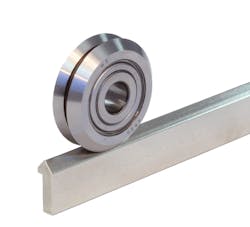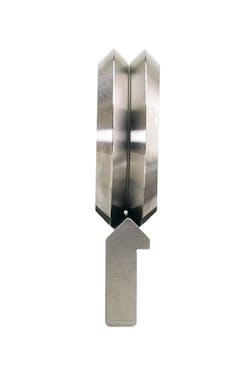Automated equipment gets a lot of attention for its high-speed, high-precision control and sensor technologies. Supporting these marquee technologies are several other components that are no less important to an automated system’s ability to dependably deliver on its high-performance promises.
One such component in automated systems that use linear motion technology is the guide wheel.
To learn more about the role of guide wheels in linear motion systems, we connected with Brian Burke, senior product engineer at Bishop-Wisecarver, a supplier of linear and rotary guide technologies and their associated components, for a recent episode of the “Automation World Gets Your Questions Answered” podcast series.Essentially, a guide wheel is a ball bearing that has a special shaped outer race. The inner and outer races of ball bearings are a framework with a groove for the balls to rest in.
Burke explained that there are different kinds of ball bearings used in linear motion systems—a single-row ball bearing, a double-row ball bearing, and a tapered roller bearing for high load capacity applications. All these ball bearing types roll on a track.
“There's a variety of matching track shapes and sizes that are meant to pair with the guide wheel,” said Burke. “When we add a drive mechanism, we call the assembly an actuator. Our actuators have either belts, chains, lead screws, or ball screw drive types that can be driven with a motor to create an automated system. The guide wheels and linear tracks get bolted to machine frames to provide precise, heavy load capacity motion.”
Bishop-Wisecarver’s most popular guide wheel is the DualVee guide wheel, which features a “W-shaped outer race, which allows it to run on either the inner V or outer V of the guide wheel,” explained Burke. “On the inner V it runs on a matching V track and on the outer V it runs inside a V track channel. This V geometry constrains motion in multiple degrees of freedom but provides smooth linear motion along the track.”
Use in automated systems
Most automated equipment is designed around welded, tubular steel frames. Machine builders design and fabricate these steel frame structures to house all the functions of a machine—much of which is typically sourced from technology suppliers, such as the motors, drives, and sensors.
Burke said the linear guide wheels and tracks that Bishop-Wisecarver supplies are assembled onto this machine frame to provide motion for the moving elements of the machine.
With so many possible applications for the guidewheels and tracks, Burke likes to reference automated packaging machinery as an easy-to-understand example of guide wheel use in linear motion systems.
“Case erectors and case packers are machines that start with flat cardboard boxes piled on one side. The machine will pull these flat cardboard pieces from a stack to form an open box for insertion of products,” said Burke. “After the products are placed into the formed boxes, the flaps get folded and are sometimes taped or glued closed. A machine like this can process a large volume of products quickly in an automatic fashion. But when you break down all these functions, you’ll see that each motion in this machine requires many moving elements that need to be precisely guided so that a repeatable result can occur.”
In many of these motion-related areas, guide wheels are frequently used components of the linear motion systems installed by the machine builder.
Other common linear motion applications using guide wheels include lab automation for sample processing and material handling applications where there's a need to move heavy or awkwardly shaped items in complex assembly operations or simply to assist workers.
Linear motion technology using guide wheels can also be found in the food processing industries, such as high-volume baking and meat processing. Burke noted that Bishop-Wisecarver is also starting to see more use of these linear motion systems in agriculture with automated harvesters.
These packaging, food processing, and harvesting applications are all considered harsh and dirty environments where debris accumulates in the machinery and can cause linear guides to fail.
“This is really where guide wheel technology can shine because of its self-cleaning ability,” added Burke. “Because of the V shape, as it rolls on a V track, it generates a sweeping action that tends to eject debris. And that's unique to the design of this guide wheel (i.e., Bishop-Wisecarver’s DualVee). These guide wheels also provide for low maintenance because they're internally lubricated with grease that doesn't need to be serviced.”
Leaders relevant to this article:




